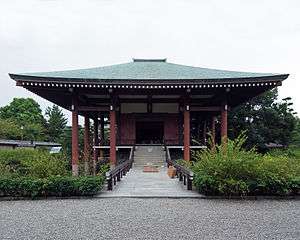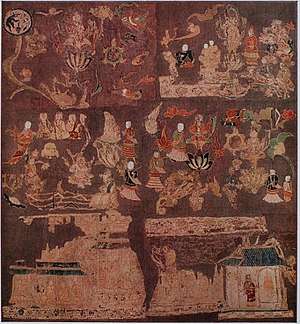Chūgū-ji
Chūgū-ji (中宮寺) is a temple in Nara Prefecture, Japan, that was founded as a nunnery in the seventh century by Shōtoku Taishi. Located immediately to the northeast of Hōryū-ji, its statue of Miroku and Tenjukoku mandala are National Treasures.

History
Chūgūji was once the palace of Hashihito, mother of Shōtoku Taishi. After her death it was converted into a temple. It was restored and converted to a nunnery by the nun Shinnyo in the late Kamakura period.[1][2] Originally standing three hundred metres to the east, it was moved to its present location in the Muromachi period.[3] Chūgū-ji is one of three nunneries in Yamato whose chief priestesses were imperial princesses.[4] The site of Chūgū-ji has been designated a Historic Site, and the Edo period Omotegomon has been registered as a cultural property.[5][6]
Miroku Bosatsu
The camphor wood statue of Miroku (菩薩半跏像) is a National Treasure dating from the Asuka period. Formerly painted, it is finished in lacquer.[3][7][8][9]
Tenjukoku Shūchō Mandala

After the death of Shōtoku Taishi in 622, his consort Tachibana-no-Oiratsume commissioned the Tenjukoku Shūchō Mandala (天寿国繍帳). The embroidery of heaven and eternal life, together with one hundred tortoises and accompanying text, was restored in the Edo period by combining the surviving fragments with parts of a Kamakura period replica.[10][11]
See also
| Wikimedia Commons has media related to Chuguji. |
References
- Lori Rachelle Meeks (2010). Hokkeji and the Reemergence of Female Monastic Orders in Premodern Japan. University of Hawaii Press. pp. 293–294. ISBN 978-0-8248-3394-7.
- Bernard Faure (10 January 2009). The Power of Denial: Buddhism, Purity, and Gender. Princeton University Press. p. 31. ISBN 1-4008-2561-X.
- Mizuno, Seiichi (1974). Asuka Buddhist Art: Horyuji. Weatherhill. pp. 78ff.
- "Chuguji Temple". Ikugara. Retrieved 19 March 2011.
- "Database of Registered National Cultural Properties". Agency for Cultural Affairs. Archived from the original on 21 July 2012. Retrieved 19 March 2011.
- "Database of Registered National Cultural Properties". Agency for Cultural Affairs. Archived from the original on 22 July 2012. Retrieved 19 March 2011.
- "Chuguji Temple". Nara Prefecture. Archived from the original on 4 March 2011. Retrieved 19 March 2011.
- Moran, S. F. (1958). "The Statue of Miroku Bosatsu of Chuguji". Artibus Asiae. 21 (3/4): 179–203. JSTOR 3248882.
- "Database of Registered National Cultural Properties". Agency for Cultural Affairs. Archived from the original on 1 August 2012. Retrieved 19 March 2011.
- Mizuno, Seiichi (1974). Asuka Buddhist Art: Horyuji. Weatherhill. p. 52.
- "The Tenjukoku Shucho Mandara". Tokyo National Museum. Retrieved 19 March 2011.